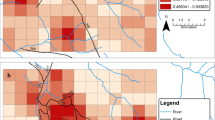Abstract
From December 1999 to December 2002, we radiocollared 25 adult (17 M, 8 F) leopard catsPrionailurus bengalensis Kerr, 1792 in Phu Khieo Wildlife Sanctuary, Thailand. We found no difference in annual survival rate between adult males (0.96 ±0.05) and females (0.87 ± 0.13), and we found no difference in mean seasonal survival rates between the dry (0.95 ± 0.04) and wet season (0.97 ± 0.04). We estimated a pooled mean annual survival of 0.92 ± 0.06 for adult leopard cats, and also estimated annual survival rates of 0.83 ± 0.24 and 0.53 ± 0.21 for leopard cats in 2 other studies. We believe our high mean annual survival estimate of adult leopard cats was related to our study site being located within a remote wildlife sanctuary with minimal anthropogenic effects.
Similar content being viewed by others
References
Acharjyo L. N. and Mishra C. G. 1980. A note on the breeding of the leopard cat (Felis bengalensis) in captivity. Journal of the Bombay Natural History Society 77: 127–128.
Acharjyo L. N. and Mishra C. G. 1983. Further notes on the birth and growth of the leopard cat (Felis bengalensis) in captivity. Journal of the Bombay Natural History Society 80: 207–208.
Austin S. C. 2002. Ecology of sympatric carnivores in Khao Yai National Park, Thailand. PhD thesis, Texas A&M University, Kingsville and Texas A&M University, College Station, Kingsville, Texas, USA: 1–158.
Bernard H. 1991. Insight guide: southeast Asia wildlife. APA Publications, Hong Kong: 1-430.
Burger L. W., Kurzejeski E. W. and Eric M. R. 1995. Survival and cause-specific mortality of northern bobwhite in Missouri. The Journal of Wildlife Management 59: 401–410.
Chamberlain M. J., Leopold B. D., Burger L. W., Plowman B. W. and Conner L. M. 1999. Survival and cause-specific mortality of adult bobcats in central Mississippi. The Journal of Wildlife Management 63: 613–620.
Dathe H. 1968. Breeding the Indian leopard cat at East Berlin Zoo. International Zoo Yearbook 8: 42–44.
Eaton R. L. 1984. Survey of smaller felid breeding. Zoologische Garten 54: 383–400.
Frese R. 1980. Some notes on breeding the leopard cat (Felis bengalensis) at West Berlin Zoo. International Zoo Yearbook 20: 220–223.
Fuller T. K., Berg W. E. and Kuehn D. W. 1985. Survival rates and mortality factors of adult bobcats in north-central Minnesota. The Journal of Wildlife Management 49: 292–296.
Fuller T. K., Berendzen S. L., Decker T. A. and Cardoza J. E. 1995. Survival and cause-specific mortality factors of adult bobcats (Lynx rufus). American Midland Naturalist 134: 404–408.
Grassman L. I. Jr 1999. Ecology and behavior of the Indochinese leopard in Kaeng Krachen National Park, Thailand. Natural History Bulletin of the Siam Society 47: 77–93.
Grassman L. I. Jr 2000. Movements and diet of the leopard cat (Prionailurus bengalensis) in a seasonal evergreen forest in south-central Thailand. Acta Theriologica 45: 421–426.
Hines J. E. and Sauer J. R. 1989. Program CONTRAST. United States Fish and Wildlife Service Technical Report 24.
Kamler J. F. and Gipson P. S. 2000. Home range, habitat selection, and survival of bobcats,Lynx rufus, in a prairie ecosystem in Kansas. Canadian Field-Naturalist 114: 388–394.
Kaplan F. L. and Meier P. 1958. Non-parametric estimation from incomplete observations. Journal of American Statistics Association 53: 457–481.
Kitchener A. 1991. The natural history of the wild cats. Comstok Publishing Associates, New York, USA: 1–280.
Kulowiec T. 1988. A program for calculation of survival rates from telemetry data using a modified Kaplan-Meier estimator allowing for staggered entries of observations. Missouri Department of Conservation, Columbia, Missouri, USA.
Kumsuk M., Kreetiyutanont K., Suyannakorn V. and Sanguanyat N. 1999. Diversity of wildlife vertebrates in Phu Khieo Wildlife Sanctuary, Chaiyaphum Province. Wildlife Conservation Division, Royal Forest Department, Bangkok, Thailand: 1–120.
Leslie P. H. 1945. On the use of matrices in certain population mathematics. Biometrika 33: 183–212.
Leslie P. H. 1948. Some further notes on the use of matrices in certain population mathematics. Biometrika 35: 213–245.
Ludlow M. E. and Sunquist M. E. 1987. Ecology and behavior of ocelots in Venezuela. National Geographic Research 3: 447–461.
Neter J. and Wasserman W. 1974. Applied linear statistical models. Richard D. Irwin, Homewood, Illinois, USA: 1–842.
Nielsen C. K. and Woolf A. 2002. Survival of unexploited bobcats in southern Illinois. The Journal of Wildlife Management 66: 833–838.
Nowell K. and Jackson P. 1996. Wild cats: status survey and conservation action plan. IUCN, Gland, Switzerland: 1–382.
Pohle Von C. 1973. Zur Zucht von Bengalkatzen (Felis bengalensis) im Tierpark Berlin. Zoologische Garten 43: 110–126.
Pollock K. H., Winterstein S. R. and Bunck C. M. 1989. Survival analyses in telemetry studies: the staggered entry design. The Journal of Wildlife Management 53: 7–15.
Rabinowitz A. R. 1990. Notes on the behavior and movements of leopard cats,Felis bengalensis, in a dry tropical forest mosaic in Thailand. Biotropica 22: 397–403.
Rajaratnam R. 2000. Ecology of the leopard cat (Prionailurus bengalensis) in Tabin Wildlife Reserve, Sabah, Malaysia. PhD thesis, Universiti Kebangsaan Malaysia, Bangi, Malaysia: 1–249.
Sauer J. R. and Williams B. K. 1989. Generalized procedures for testing hypothesis about survival or recovery rates. The Journal of Wildlife Management 53: 137–142.
Sunquist M. E. and Sunquist F. 2002. Wild cats of the world. University of Chicago Press, Chicago, Illinois, USA: 1–452.
Winterstein S. R., Pollock K. H. and Bunck C. M. 2001. Analysis of survival data from radio-telemetry studies. [In: Radio tracking and animal populations. J. J. Millspaugh and J. M. Marzluff, eds]. Academic Press, San Diego, CA, USA: 352–379.
Author information
Authors and Affiliations
Additional information
Associate Editor was Joseph F. Merritt.
Rights and permissions
About this article
Cite this article
Haines, A.M., Grassman, L.I. & Tewes, M.E. Survival of radiocollared adult leopard catsPrionailurus bengalensis in Thailand. Acta Theriol 49, 349–356 (2004). https://doi.org/10.1007/BF03192533
Received:
Accepted:
Issue Date:
DOI: https://doi.org/10.1007/BF03192533




